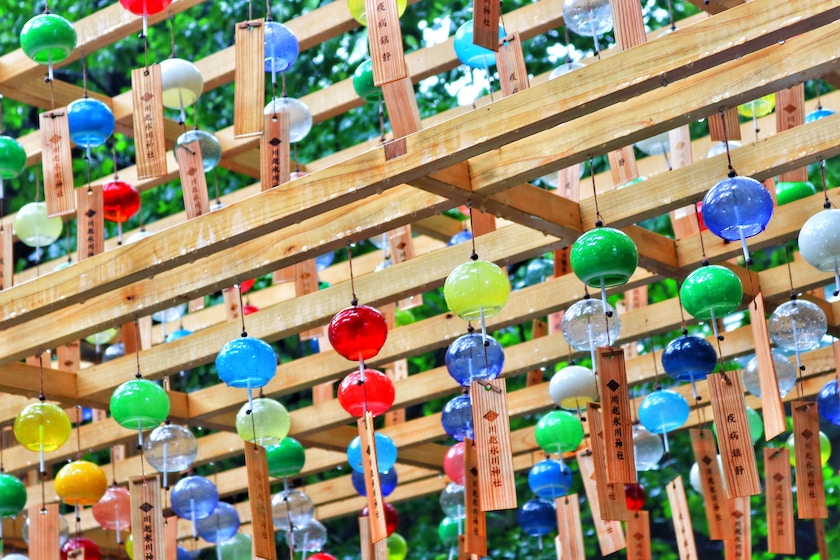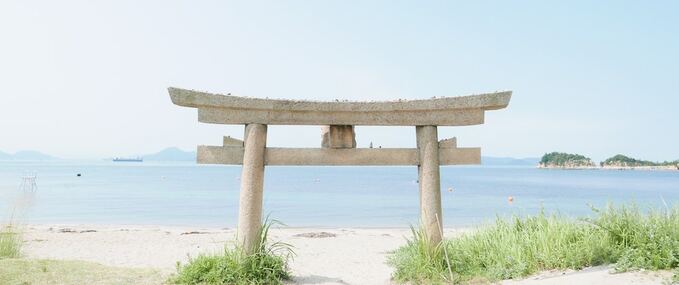Here comes the sun! Summer is a wonderful time to experience the wonders of Japan with a huge amount to see and do.

Intro
It’s summer! The sun is shining, the sea is glistening, and the outdoors is calling. Summer in Japan is glorious. From festivals to fireworks, swimming in the crystal water to enjoying summer food in the country’s beautiful green spaces, it’s a wonderful time to visit this incredible country, especially if you love the sunshine and having fun outdoors. If you’re planning a visit to Japan during the hotter summer months, it’s important to plan ahead for what to expect, from the warm weather to the rainy season, the best clothing to wear, places to go, things to do, and how to get around with the Japan Rail Pass. Thankfully, we’re here to tell you about all of that and more. 
What is summer like in Japan?
Summer in Japan is glorious. It can get very hot and very humid, but it can also be wet due to the rainy season. Japan’s summer takes place across June, July, and August. Temperatures can range from 65°F to up to 93°F in these months, and tend to peak in July, with early June and late August being slightly cooler. June is also the beginning of Japan’s rainy season and is known as the month of water, but don’t let that put you off. Read more about why June: the Month of Water is a Hidden Gem, to find out why it’s also a great time to visit. July and August are the hottest months, but this does vary across the country. For instance, Hokkaido in the north is always much colder, and Okinawa in the south is warm practically all year round. Generally speaking though, June to August are Japan’s hottest months and the country’s official summer. Over the peak summer months, humidity can be as much of an issue as the heat, so make sure you find ways to stay cool, drink lots of water, use sunscreen, and dress appropriately. You may also want to keep a compact umbrella handy too in case of rain. Overall though, you should be treated to some truly stunning summer weather and there’s no shortage of exciting things to do. 
Summer Festivals
We’ve said it before, but Japan loves festivals, especially during the summer. There are an estimated 300,000 Matsuri across Japan, and several thousand over the summer months. There are so many ‘matsuri’ because almost every shrine, town and village has its own festival. The focal-point of these can vary, from honouring a shrine’s kami (a Shinto deity), to remembering an important historical event, or celebrating a particular season such as summer. Traditional matsuri feature processions and decorated floats known as dashi, yatai, danjiri, and other regional variations. Kami are sometimes carried from their shrines in mikoshi (essentially a portable shrine carried by the procession), and processions are often accompanied by drum and flute music. However, each matsuri is also slightly different, with its own unique personality and characteristics. While some are serene and peaceful, others are colourful, loud and energetic, and feature dancing and singing. Traditional matsuri are a great way to experience the history and culture of Japan and summer arguably brings together the most colourful and spectacular. Look out for summer parades, floats, decorations, dancing, food, games, fireworks, and more!
One particularly famous summer festival to look out for is Gion Matsuri in Kyoto. The festival dates back to 869 and the grand procession of floats - Yamaboko Junko - is so spectacular and so significant to the people of Kyoto, and the rest of Japan, that it has been registered with UNESCO as an Intangible Cultural Heritage of Humanity. For a full guide to this famous festival, read Experiencing the Gion Matsuri in Kyoto. Also in July is Tenjin Matsuri at Tenmangu Shrine in Osaka, which attracts over 1.5 million visitors each year. The temple is closely located to the station called JR Osaka Tenmangu station, which can be reached using the JR Osaka Loop Line and Japan Rail Pass. For a different kind of festival, you could also check out Soma Nomaoi, a three-day celebration of martial arts and horsemanship in northeast Honshu, which also takes place each year in July. To reach Soma, take the JR Tohoku Shinkansen line to Sendai and switch to the JR Joban line for Soma. Also taking place over the summer, is the famous Obon festival, and the Tanabata Star Festival. For a full list read our guide to Summer Festivals in Japan: the Expert Guide.
Japan’s Rainy Season
If you’re travelling to Japan in the summer you’ll need to be aware of the potential for rain. Japan’s rainy season is caused by warm bodies of air, from Southeast Asia and the North Pacific, colliding with colder air from the Sea of Okhotsk and China. Although the level of rain and the timing can vary year on year, and geographically by area of Japan, it can result in continuous heavy rain from mid-June to mid-July over the Japanese archipelago. Don’t despair too much if you’re planning to visit Japan during these months, however, as some days it hardly rains at all. The timing of Japan’s rainy season can vary slightly depending on which part of Japan you’re visiting. The southernmost Japanese islands, such as Okinawa, are the first to experience the rainy season. It can sometimes begin as early as May in sub-tropical Okinawa. At the other end of the spectrum you have Tohoku. The rainy season tends to begin later here, usually June to July. Either way, you’re looking at the months of May to July. Typically, June is the month most closely associated with the rainy season in Japan – so much so that it is referred to as ‘minazuki’ or ‘the month of water’. Japan’s rainy season does have a number of positives though - this beautifully green country is at its greenest due to the rainfall, popular attractions tend to be quieter, and thanks to the huge number of indoor attractions and activities in Japan, you’ll never be short of things to do. Read our guide to Japan’s Rainy Season for more. 
Summer Fireworks
Unlike most countries where fireworks are linked with autumn and winter, in Japan, these dazzling displays are very much a summer activity. The word ‘hanabi’ in Japanese means ‘flower fire’ - a very apt and beautiful description for fireworks, which hints at their cultural significance in Japan. Hanabi first became popular during the Edo period as a symbol and celebration of spiritual beauty. They have also been historically used to ward off evil spirits, and in the modern era have become synonymous celebrations, from summer festivals and major sporting & music events, through to bringing in the New Year. Sumidagawa Fireworks Festival in Tokyo is arguably the oldest and most historic firework display in Japan and takes place every summer. Tokyo’s Sumida River Fireworks Festival dates back to the 1700s and is staged on the last Saturday in July each year along the river. You can reach the area via Asakusa Station. The festival is also close to Tokyo’s famous Sensoji Temple. For a list of the most famous fireworks festivals across Japan read our in-depth guide to Hanabi: Japanese Fireworks. Outdoor Activities in Japan
Summer is the perfect time to get outdoors and Japan offers a very wide-ranging selection of activities thanks to its diverse landscape, which includes mountains, forests, and lakes, as well as lush countryside and idyllic beaches. Climbing and hiking, kayaking and canoeing, cycling, swimming, diving, watersports, and much more, are all very popular and very accessible activities in Japan. If you love the great outdoors, you’ll be spoilt for choice. There are also more sedate and relaxing outdoor activities available from visiting green tea plantations and rice fields to visiting fruit farms and flower gazing. 
The summer months see some of Japan’s most beautiful flowers bloom. If you love flowers, you’ll be spoiled for choice in Japan - there are almost too many amazing flower parks and fields to mention. But we’ll try! Yamana Flower Park is located at the base of Mt. Fuji and close to lake Yamanaka, one of the Fuji Five Lakes. At different times of the year, there are over one million seasonal flowers that make for the most colourful display of Fuji, you’ll even see. The park is relatively unknown, but highly recommended on any visit to the area, such as on a day trip to Kawaguchiko (another of the Fuji Five Lakes). Other flower destinations, depending on your itinerary, including the famous Lavender fields in Furano. 
Summer Food & Drink
Japan is famous for its world-leading food and drink and summer sees a wide range of delicious specialty dishes come to the forefront. Here are a few summer dishes to look out for:
- Kakitori: Shaved ice with syrup. This is one of Japan’s favourite summer foods and perfect for cooling down.
- Goya: A bitter melon that grows in the summer months, goya is very good for you but has a love it or hate it flavour. It’s sometimes cooked in a larger dish with other ingredients such as the Okinawan speciality goya-champuru which features pork, tofu, bean sprouts, and egg as well as goya.
- Hiyayakko: A cold tofu dish traditionally topped with katsuobushi fish flakes and spring onions with ginger and soy sauce.
- Watermelon: A delicious slice of watermelon served fresh.
- Nagashi Somen: This is almost like a festival game in itself! Diners have to grab cold, somen noodles as they slide down a bamboo chute. You can then dip your noodles in a soy-style sauce.
- Yakitori: Skewered meat grilled over charcoal – the beautiful simplicity and amazing taste of Yakitori makes it a street food favourite in Japan.
- Tomorokoshi: People are often surprised that corn cobs (which are often seen as being quintessentially American) are so popular in Japan, especially from Yatai street vendors and Matsuri stalls. Of course, the Japanese version is unique and delicious – it is grilled with miso, butter, and soy and served on a stick. Tomorokoshi is traditionally associated with the Hokkaido region. For more suggestions, read our guide to Japanese Food and Regional Dishes.
Japan’s Seasons
One of the most-common questions people have while planning a trip to Japan is about the best time of year to travel there. Ultimately, there is no right or wrong answer here. All four of Japan’s seasons offer unique and wonderful experiences and have a personality and character all their own. The true answer is that it’s really down to you and your own preferences when it comes to weather and activities. If you love cold climates and snow then naturally a visit to Japan in winter will be magical and will open up activities such as snowboarding and skiing. If you’re a sun worshipper on the other hand and love the beach, then the summer or autumn months will be ideal for you. Similarly, if you want to see the famous cherry blossoms then you’ll need to travel during spring. However, that’s also one of the busiest times of year for tourists so that’s something you’ll want to consider. If you don’t like crowds, then you may prefer visiting during plum blossom season or autumn to see the golden leaves fall. Each of Japan’s seasons are beautiful in their own right. It’s just a case of which one is right for you. Of course, if you travel to Japan more than once and become a repeat visitor then you can choose to experience a different season every time! Read our guide, When Is The Best Time To Visit Japan?, for an in-depth overview of each season, the weather conditions, popular activities, and more. Finally, for more on Japan’s weather specifically, read our post on Japan’s Seasons and Weather. Bonus Recommendations
- Stay ahead of the weather by keeping an eye on the latest online forecast. To do this, we recommend purchasing a PocketWifi device for unlimited WIFI 24/7 on up to 10 devices.
- Visiting Japan for the first time in the summer? If you need a helping hand, try our Meet and Greet Service - it’s like having a personal assistant (and Japan expert) on hand to help with your holiday.
- When travelling to Japan in the summer months, remember to pack suitable light clothing, including different kinds of footwear, and waterproof items for when it rains, and don’t forget sunscreen. Temperatures can reach 93°F.
- If travelling to Japan in the height of summer sounds much too hot for you, then how about autumn, spring, or winter? Our hand-picked bonus recommendations can help you plan a trip during the rest of the year.
- As we mentioned above, Spring is one of the most popular times of year to visit Japan. It's famous for being Cherry Blossom Season, which attracts millions of visitors, but it’s a lovely time of year in Japan generally with lots to see and do. Read our guide Spring in Japan for lots of ideas and useful information.
- Autumn brings beautiful golden colours to Japan as well as a wealth of fun and interesting attractions and activities. Cooler and quieter, but just as beautiful, Autumn in Japan is definitely worth considering.
- If summer isn’t your thing, then winter in Japan might be right up your street. It’s a magical time of year to visit this beautiful country. Our guide to Spending Winter in Japan has everything you need to know.





